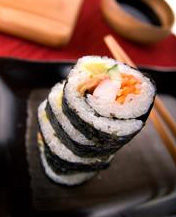专题:Nature系列

人肠道微生物群落所起的有用作用之一是,提供人类基因组中所缺的消化酶。例如,来自在整个演化过程中一直是人类饮食构成部分的陆地植物的多糖,就是在肠道中被碳水化合物活性酶(CAZymes)分解的,它们当中很多都是来自类杆菌的具有高度特异性的酶。然而,人们对帮助消化可食性海藻如紫菜、海白菜和裙带菜(常见于日本菜)的肠道酶却知之甚少。
现在,能够消化来自紫菜类红海藻的硫酸多糖的碳水化合物活性酶已在海洋类杆菌分离菌种中被发现。出乎意料的是,基因组数据挖掘显示,这种酶存在于日本人的肠道细菌中,但在美国人的肠道细菌中却没有。
这表明,最近(这里说的“最近”是从演化意义上来讲的)发生了从一种来自海洋环境的类杆菌向日本人肠道细菌"Bacteroides plebeius"的基因转移。紫菜传统上用于寿司中,这表明,接触未灭菌的食物,在带有不同碳水化合物活性酶的肠道细菌在体内积累中是一个普遍因素。
生物谷推荐原文出处:
Nature 464, 908-912 (8 April 2010) | doi:10.1038/nature08937
Transfer of carbohydrate-active enzymes from marine bacteria to Japanese gut microbiota
Jan-Hendrik Hehemann1,2,3, Ga?lle Correc1,2, Tristan Barbeyron1,2, William Helbert1,2, Mirjam Czjzek1,2 " Gurvan Michel1,2
1 Université Pierre et Marie Curie, Paris 6,
2 Centre National de la Recherche Scientifique, Végétaux marins et Biomolécules UMR 7139, Station Biologique de Roscoff, Roscoff F 29682, France
3 Present address: Biochemistry and Microbiology, University of Victoria, PO Box 3055 STN CSC, Victoria, British Columbia V8W 3PG, Canada.
Gut microbes supply the human body with energy from dietary polysaccharides through carbohydrate active enzymes, or CAZymes1, which are absent in the human genome. These enzymes target polysaccharides from terrestrial plants that dominated diet throughout human evolution2. The array of CAZymes in gut microbes is highly diverse, exemplified by the human gut symbiont Bacteroides thetaiotaomicron 3, which contains 261 glycoside hydrolases and polysaccharide lyases, as well as 208 homologues of susC and susD-genes coding for two outer membrane proteins involved in starch utilization1, 4. A fundamental question that, to our knowledge, has yet to be addressed is how this diversity evolved by acquiring new genes from microbes living outside the gut. Here we characterize the first porphyranases from a member of the marine Bacteroidetes, Zobellia galactanivorans, active on the sulphated polysaccharide porphyran from marine red algae of the genus Porphyra. Furthermore, we show that genes coding for these porphyranases, agarases and associated proteins have been transferred to the gut bacterium Bacteroides plebeius isolated from Japanese individuals5. Our comparative gut metagenome analyses show that porphyranases and agarases are frequent in the Japanese population6 and that they are absent in metagenome data7 from North American individuals. Seaweeds make an important contribution to the daily diet in Japan (14.2?g per person per day)8, and Porphyra spp. (nori) is the most important nutritional seaweed, traditionally used to prepare sushi9, 10. This indicates that seaweeds with associated marine bacteria may have been the route by which these novel CAZymes were acquired in human gut bacteria, and that contact with non-sterile food may be a general factor in CAZyme diversity in human gut microbes.







